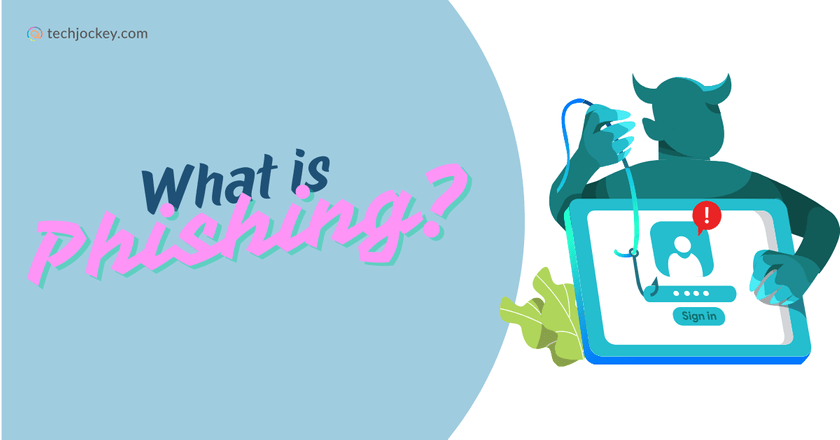What is Phishing? Understanding Phishing Attacks & Online Security

From being a relatively small-scale scam in the early days of email, phishing attack has today become one of the most widespread and costly cyber threats.
For with the advancement of technology comes that of cybercriminals, who are almost always on the lookout for creative ways to manipulate people and rob them of their privacy.
Besides, with the majority of human interactions, be it social, financial, commercial, or religious, taking place online, the need to identify and prevent phishing scams has never been greater. For businesses and individuals alike, knowing what it is, is a prerequisite to building cyber security awareness.
In this write-up, we break down phishing definition, explore its many forms, see real-life phishing examples, and cover steps to protect yourself and your organization, so you can stay informed and prepared, no matter what comes your way!
What is a Phishing in Cyber Security?
As per the phishing definition provided by cyber security experts, it is a fraudulent attempt to obtain sensitive information by pretending to be a legitimate entity in digital communication.
In simple terms, it is a type of cyber-attack wherein cybercriminals try to trick a person into sharing confidential data, clicking on malicious links, or installing harmful software.
To obtain the same, they disguise themselves as entities, such as banks, government bodies, online platforms etc., or even peers who can be trusted. This, so the victims blindly trust every word that comes out of their mouth and get manipulated easily.
Phishing, as such, is a form of social engineering that takes advantage of human trust instead of technical flaws in computers or networks.
Also, while many of you may be of the opinion that phishing is just about emails, the said attack now extends into phone calls, text messages, and even fake websites.
How Does Phishing Work?
To say that it is easy for attackers to carry out phishing attacks is a misleading oversimplification. For, with growing cyber security awareness, attackers often find it hard to make their scams look believable. In order to truly understand what all goes into making phishing what it is today thus, keep reading…
1. Researching Targets:Phishers who are proficient enough, especially those involved in spear phishing, try and identify their victims first. They either research the company hierarchies or scroll through LinkedIn to find their potential targets. If nothing works, they scrape email addresses.
2. Crafting the Bait: The attacker then creates a deceptive message that looks legitimate. This can either be an email from a bank requesting identity verification, a security alert from an online store, or a missed delivery notice from a courier service.
3. Delivery of the Message: The phishing mail is then distributed widely through bulk email campaigns, or, in the case of spear phishing, sent in a highly personalized manner to a specific target.
4. Hooking the Victim: The message generally consists of a phishing link or attachment that looks believable enough to make the victims click on it. And once they do, they are led to a fake login page or malicious software requesting download.
5. Harvesting the Data: Any information the targets then enter such as usernames, passwords, or banking credentials, is then collected by the attackers. Malware infections may also give criminals ongoing access to the victim’s system.
6. Exploitation: Finally, stolen information is used directly for fraud, for example, wire transfers or account takeovers. It can also be sold on the dark web in other instances. This cycle continues because phishing attacks, in sooth, are relatively cheaper to execute and highly scalable.
Types of Phishing Attacks
Criminals today conduct phishing in a variety of ways, making it a tough cyber-attack to defend against. The various types of phishing attacks are listed below to help you stay clear of its varied traps…
- Email Phishing: Email phishing is the most common form of phishing, wherein the attackers send a phishing mail to their targets. This mail claims there’s an urgent problem with your bank account, asking you to click a link.
- Spear Phishing: In spear phishing, attackers target specific individuals or companies instead of sending generic scams. Since it gets into the specifics, it often contains personal details, so the request looks authentic.
- Whaling: Whaling or whale phishing is similar to spear phishing, but it is directed at high-level executives or decision-makers who control sensitive corporate resources. The stakes in this attack are thus higher.
- Smishing (SMS Phishing): Smishing is when phishing is done using text messages. This includes texts related to fake delivery notices, fraud alerts, or prize claims.
- Vishing (Voice Phishing): Vishing is phishing conducted through phone calls. Attackers, to conduct this attack, impersonate banks, tax authorities, or tech support, asking victims to verify details or install fake software.
- Clone Phishing: In clone phishing, attackers clone an original email the victim once received. By cloning we mean, keeping the content of the email largely same, but replacing attachments or links with malicious content.
- Pharming: Pharming is when cybercriminals manipulate web traffic, leading victims from legitimate websites to fraudulent copies without their knowledge.
Examples of Phishing
We have listed some of the most commonly occurring phishing examples below for your convenience…
- Banking Scam Emails: You receive an email that looks like it’s from your bank, urging you to verify account details to avoid suspension. The phishing link, if clicked on, leads you to a false login page.
- Delivery Notifications: Emails or SMS stating, Your package delivery failed; click here to reschedule, are some of the most common scams.
- Charity & Disaster Relief Frauds: Criminals exploit global crises like pandemics or natural disasters to send phishing mails urging people to donate.
- Corporate Invoice Scams: Businesses often face fake invoices or payment requests disguised as supplier communications.
- Social Media Login Traps: Attackers send messages like Check who viewed your profile with phishing links that are programmed to steal your social media credentials.
What makes the aforementioned phishing scams dangerous is the fact that they try and imitate real-world communications that we can fall for easily.
People thus need to watch out for red flags like poor grammar, suspicious links, or unexpected requests in order to stay safe.
Why Phishing Works?
To fully understand what phishing means in cyber security, one needs to know why it works so well. Because it exploits our psychological triggers like…
- Fear: Your bank account will be locked unless you act now.
- Curiosity: Click here to see who sent you a message.
- Urgency: Only 24 hours left to verify your account!
- Authority: Emails appearing to come from senior executives or government bodies.
- Greed: Congratulations! You have won a grand prize.
Recognizing these social engineering tactics makes it easier to resist from such attempts.
What to Do If You Fall Victim to Phishing?
Despite best efforts, anyone can fall prey to phishing attacks. If it happens, swift action can minimize damage. Here’s how…
- Don’t panic but act quickly.
- Immediately change passwords for compromised accounts.
- Enable Two-Factor Authentication (2FA) wherever possible.
- Contact your bank or credit card company to freeze accounts and reverse unauthorized transactions.
- Run a security scan to detect malware or spyware on your device.
- Report the incident to your employer’s IT department or national cyber security agencies.
- Forward the phishing mail to official anti-phishing email addresses such as government hotlines.
- Monitor for identity theft by watching your credit reports, online profiles, and financial statements.
The faster you respond, the lower the chances that cybercriminals can exploit the stolen information.
How to Prevent Phishing?
Effective prevention of phishing requires both awareness and practical defence measures. Here’s how you can reduce the chances of falling into a trap…
- Be Skeptical of Urgent Requests: It is a type of scam that thrives on urgency and fear. So, take time to verify everything you receive.
- Check Sender Addresses Carefully: A phishing mail often uses subtle variations of genuine email addresses. So, check sender addresses before replying to any mail.
- Hover Over Links Before Clicking: This helps reveal the real URL hiding behind a malicious link.
- Avoid Downloading Unknown Files: Attachments may contain malware. Only download them if you are sure about them.
- Use Strong, Unique Passwords: Never recycle passwords across accounts.
- Enable Multi-Layered Security: Two-factor authentication reduces risk even if credentials are stolen.
- Invest in Updated Cyber Security Software: Firewalls, anti-malware, and email filters catch many phishing attempts.
- Educate Yourself & Others: In workplaces, regular training sessions on types of phishing make employees more alert.
The Future of Phishing
Phishing isn’t going away, in fact, it is evolving. Attackers are increasingly using artificial intelligence to come up with more convincing phishing scams. Deepfake technology, for instance, is being applied to vishing attacks, where scammers use AI-generated voices of CEOs to authorize fraud payments.
It is thus clear that it is a type of cybercrime that will adapt alongside new digital habits, making awareness a critical ongoing responsibility.
Conclusion
To have an in-depth understanding of what is phishing and how is it critical to survive in the digital world we live in. It is a type of cyber threat that can compromise your finances, your data, and even national security. It impacts everyone you can think of. From individuals to large enterprises, you name it!
Thus, knowing how to prevent such scams is your best defence. As cyber criminals continue to innovate, don’t just wait but retaliate with your awareness.
If you need any technical assistance for the same, get in touch with the Techjockey cybersecurity consultant today itself and get the best cyber security software at your service.
Yashika Aneja is a Senior Content Writer at Techjockey, with over 5 years of experience in content creation and management. From writing about normal everyday affairs to profound fact-based stories on wide-ranging themes, including environment, technology, education, politics, social media, travel, lifestyle so on and so forth, she... Read more




























